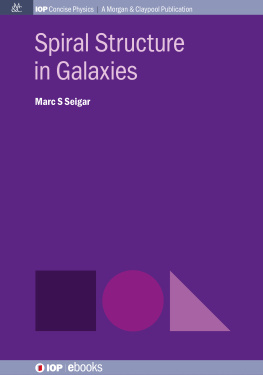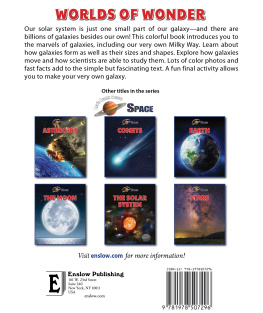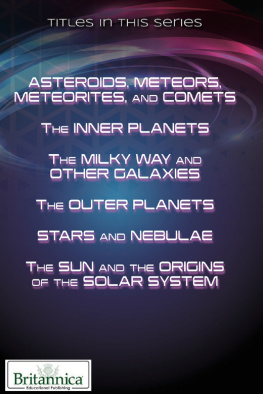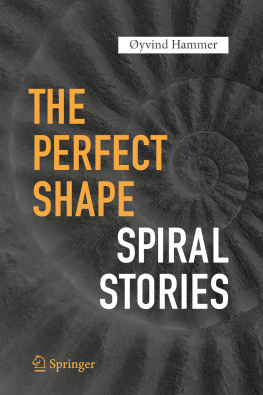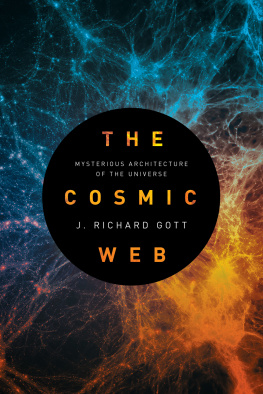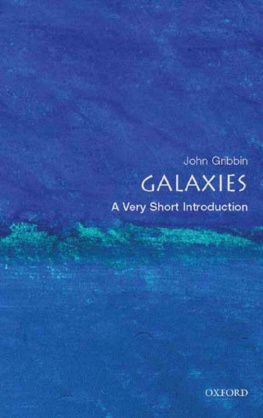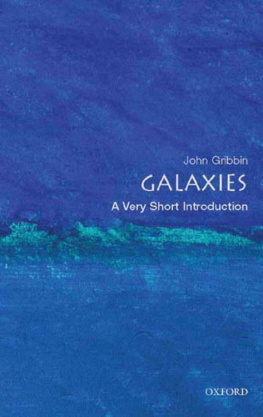Marc S Seigar - Spiral structure in Galaxies
Here you can read online Marc S Seigar - Spiral structure in Galaxies full text of the book (entire story) in english for free. Download pdf and epub, get meaning, cover and reviews about this ebook. year: 2017, publisher: Morgan & Claypool Publishers, genre: Romance novel. Description of the work, (preface) as well as reviews are available. Best literature library LitArk.com created for fans of good reading and offers a wide selection of genres:
Romance novel
Science fiction
Adventure
Detective
Science
History
Home and family
Prose
Art
Politics
Computer
Non-fiction
Religion
Business
Children
Humor
Choose a favorite category and find really read worthwhile books. Enjoy immersion in the world of imagination, feel the emotions of the characters or learn something new for yourself, make an fascinating discovery.
- Book:Spiral structure in Galaxies
- Author:
- Publisher:Morgan & Claypool Publishers
- Genre:
- Year:2017
- Rating:5 / 5
- Favourites:Add to favourites
- Your mark:
- 100
- 1
- 2
- 3
- 4
- 5
Spiral structure in Galaxies: summary, description and annotation
We offer to read an annotation, description, summary or preface (depends on what the author of the book "Spiral structure in Galaxies" wrote himself). If you haven't found the necessary information about the book — write in the comments, we will try to find it.
Spiral structure in Galaxies — read online for free the complete book (whole text) full work
Below is the text of the book, divided by pages. System saving the place of the last page read, allows you to conveniently read the book "Spiral structure in Galaxies" online for free, without having to search again every time where you left off. Put a bookmark, and you can go to the page where you finished reading at any time.
Font size:
Interval:
Bookmark:

Marc S Seigar
Department of Physics and Astronomy, University of Minnesota Duluth, USA
Morgan & Claypool Publishers
Copyright 2017 Morgan & Claypool Publishers
All rights reserved. No part of this publication may be reproduced, stored in a retrieval system or transmitted in any form or by any means, electronic, mechanical, photocopying, recording or otherwise, without the prior permission of the publisher, or as expressly permitted by law or under terms agreed with the appropriate rights organization. Multiple copying is permitted in accordance with the terms of licences issued by the Copyright Licensing Agency, the Copyright Clearance Centre and other reproduction rights organisations.
Rights & Permissions
To obtain permission to re-use copyrighted material from Morgan & Claypool Publishers, please contact .
ISBN 978-1-6817-4609-8 (ebook)
ISBN 978-1-6817-4608-1 (print)
ISBN 978-1-6817-4611-1 (mobi)
DOI 10.1088/978-1-6817-4609-8
Version: 20170601
IOP Concise Physics
ISSN 2053-2571 (online)
ISSN 2054-7307 (print)
A Morgan & Claypool publication as part of IOP Concise Physics
Published by Morgan & Claypool Publishers, 40 Oak Drive, San Rafael, CA, 94903 USA
IOP Publishing, Temple Circus, Temple Way, Bristol BS1 6HG, UK
For my wife, Colleen,
and my boys, David and Andrew
A spiral galaxy is a type of galaxy originally described by Edwin Hubble in his 1936 work The Realm of Nebulae and, as such, forms part of the Hubble sequence. Spiral galaxies consist of a flat, rotating disk containing stars, gas and dust, and a central concentration of stars known as the bulge. These are surrounded by a much fainter halo of stars, many of which reside in globular clusters.
Spiral galaxies are named for the spiral structures that extend from the center into the galactic disk. The spiral arms are sites of ongoing star formation and are brighter than the surrounding disk because of the young, hot OB stars that inhabit them. Roughly two-thirds of all spirals are observed to have an additional component in the form of a bar-like structure, extending from the central bulge, at the ends of which the spiral arms begin. The proportion of barred spirals relative to their barless cousins has changed over the history of the Universe, with only about 10% containing bars about 8 billion years ago, to roughly a quarter 2.5 billion years ago, until the present, where over two-thirds of the galaxies in the visible Universe have bars.
This book focuses on why these disk-shaped (or spiral) galaxies have spiral arms. Why do these structures exist? Why are they so stable? And what is the connection between the spiral arms and the star formation that is seen within them? In this book you will find the answers to these questions and more.
Marc S Seigar
Department of Physics and Astronomy
University of Minnesota Duluth
Duluth, MN, USA
5 May 2017
I wish to thank all of my family and friends. In particular, I want to thank my PhD advisor, Professor Philip James, without whom I would never have become interested in spiral structure in galaxies. I wish to thank all of my collaborators, in particular Andy Adamson, Misty Bentz, Joel Berrier, Jane Buckle, James Bullock, Benjamin Davis, Chris Davis, Herwig Dejonghe, Tim de Zeeuw, Fabio Gastaldello, Alister Graham, Philip Humphrey, Helmut Jerjen, Daniel Kennefick, Julia Kennefick, Olga Kuhn, Claud Lacy, Sandy Leggett, Paul Lynam, Burcin Mutlu-Pakdil, Ivanio Puerari, Nickolas Rees, Heikki Salo, Doug Shields, Amber Sierra (Harrington), Massimo Stiavelli, Patrick Treuthardt, Thor Wold, Watson Varricatt, and Luca Zappacosta, and many more.
I want to thank all of my friends and colleagues who have helped me through the years, particularly Haydar Al-Shukri, Matt Andrews, Brian Berry, John Bush, Chris Collins, Toni Empl, Jeff Gaffney, Michael Gealt, Anindya Ghosh, Joshua Hamilton, Molly Harney, Keith Hudson, Darin Jones, Tansel Karabacek, Johanna Lewis, Howard Mooers, Patrick Pellicane, Julian Post, Jeff Robertson, Jim Rock, Derek Sears, Hazel Sears, and Amber Straughn.
My friends with whom I have had so much fun over the years, I thank you all: Liz Alvarez, Roberto Avila, Renee and Kirt Booth, Alex Bouquin, Marc Cohen, Richard Dolman, Michael Fahrenwald, Paul Harman, Breanna and Bill Johnson, Martin Johnston, Melissa and Ivan Mitchell, Erik Rau and Elle Bublitz, Helene Schuller and Todd Chelson, Jamie and Dan Sweeney, Sonal and Gavin Whitlock, amongst others.
I wish to thank the editorial and production teams and Morgan & Claypool and IOP Publishing for making the process of writing and publishing this book fairly easy and straightforward.
Finally, I would like to thank my parents, Vivienne and Michael Seigar, who always encouraged me. Without them, I would not be where I am today.
Marc S Seigar

Marc S Seigar is a Professor of Astrophysics and Associate Dean of the Swenson College of Science and Engineering at the University of Minnesota Duluth (UMD). He is also the current director of the Marshall W Alworth Planetarium at UMD. Prior to his arrival at UMD, he worked as a Professor of Astrophysics at the University of Arkansas at Little Rock, a Project Scientist at the University of California, Irvine, and a Staff Astronomer at the United Kingdom Infrared Telescope. Professor Seigar has published numerous papers and conference proceedings articles in the field of galaxy dynamics, spiral structure, and dark matter.
William Parsons, 3rd Earl of Rosse (a photograph of whom can be seen in figure ) and colloquially known as the Leviathan of Parsonstown, was the worlds largest telescope, in terms of aperture size, until the early 20th century.
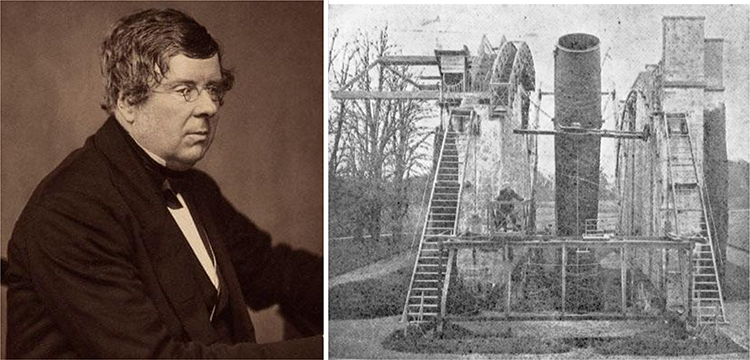
Figure 1.1. Left panel: William Parsons, 3rd Earl of Rosse, image courtesy Wikipedia. Right panel: The 72 inch refracting telescope at Birr Castle, the largest telescope of its time, colloquially known as the Leviathan of Parsonstown.
During the 1840s, Rosse had the Leviathan of Parsonstown built, a 72 inch (6 feet/1.83 m) telescope at Birr Castle, Parsonstown, County Offaly, Ireland. The 72 inch (1.8 m) telescope replaced a 36 inch (910 mm) telescope that he had built previously. He had to invent many of the techniques he used for constructing the Leviathan, both because its size was without precedent and because earlier telescope builders had guarded their secrets or had simply failed to publish their methods. Details of the metal, casting, grinding and polishing of the 3 ton speculum were presented in 1844 at the Belfast Natural History Society. Rosses telescope was considered a marvelous technical and architectural achievement, and images of it were circulated widely within the British Commonwealth. Building of the Leviathan began in 1842 and it was first used in 1845; regular use waited another two years, due to the Great Irish Famine. Using this telescope, Rosse saw and cataloged a large number of nebulae (including a number that would later be recognized as galaxies).
Font size:
Interval:
Bookmark:
Similar books «Spiral structure in Galaxies»
Look at similar books to Spiral structure in Galaxies. We have selected literature similar in name and meaning in the hope of providing readers with more options to find new, interesting, not yet read works.
Discussion, reviews of the book Spiral structure in Galaxies and just readers' own opinions. Leave your comments, write what you think about the work, its meaning or the main characters. Specify what exactly you liked and what you didn't like, and why you think so.

